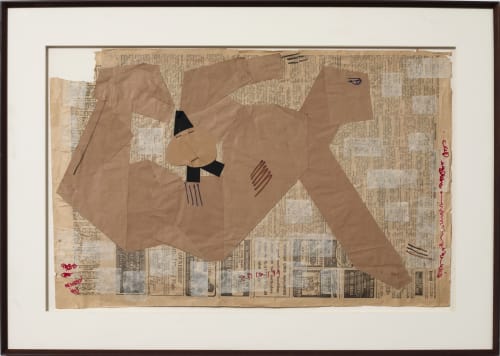The acclaimed Santiniketan pedagogue and artist Benodebehari Mukherjee – whose path-breaking experiments with materials via an integrated approach to art and craft and whose making of a contextual Indian modernism in conversation with international practices were visionary developments as a result of his life’s work – ironically grappled with declining vision from a young age. With complete blindness in one eye and myopic sight in the other, Mukherjee could not hope for a traditional education in his childhood.
Over his decades-long career, Mukherjee travelled out of Bengal to Nepal, Mussoorie, Bihar as well as the Far East, carrying forward from his travels a cultural cross-pollination of sorts in the paintings, drawings, scrolls, murals and later collages that he prolifically produced. A significant aspect of Indian art historical modernism is the dedication artists expressed towards discovering, refining and evolving a unique visual language that would more or less stay consistent over their oeuvres. Mukherjee’s declining vision poised him to see the world differently than his contemporaries. In 1957, struggling more than ever with his deficient sight, Mukherjee opted for an eye surgery that was completely unsuccessful, rendering him totally blind. Yet he continued to create work for twenty-three more years, relying on the now-ingrained sense of balance from his representational techniques by breathing intuitive constructions into his abstractions. His post-blindness years indemnify Mukherjee as a self-reflexive artist, for whom overt sight straggled behind keen insight.
Through Wakefulness, A Night Rising presents a special body of work (from the early 1920s to the late 1950s) from across Mukherjee’s travels and interests, including landscapes, figurations, flower studies, wood-cuts self-portraits as well as some post-blindness collages and compositions that create a memorable discourse around how vision appeared to him. Mukherjee’s poignant reclamation of sight through intuition – replacing overt realism – suggests an unexpected but distinctive brand of late modernism in which individual perspective is prioritized through a vocabulary of motifs. Still, in some sense, the changing dichotomies of intimacy and distance that he explored in his practice were united in a kind of “indigenous modernism” through calligraphic techniques – and reveal his intention of maintaining an artistic and aesthetic approach even after he went blind, almost as if Mukherjee himself was preparing for total darkness in his search for the particularities of life through experience.
We’re happy to welcome visitors to the gallery as well as make virtual engagement a possibility through a multi-dimensional mapping of the show, available on our website. A comprehensive e-catalogue is also available on request. For all inquiries, please write to art@vadehraart.com.

